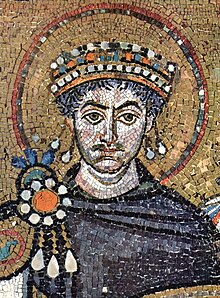| Key event(s): |
|
 |
| Chronology: |
|
| History of Lebanon |
|---|
 |
| Timeline |
|
|
This article lists historical events that occurred between 501–600 in modern-day Lebanon or regarding its people.
The land of what is now Lebanon was ruled by the following Byzantine emperors during the 6th century:
Due to mass administrative reforms and edicts directed at Phoenice Libanensis (lit. 'Lebanese Phoenicia') with the goal of preventing further pro-Sassanid raids and invasions, the province was now ruled by two ducēs during the reign of Justinian I.[3][4]

Procopius speaks in his Secret History of the economic situation in the major cities of Lebanon at the time: "Silken garments had for a long time been made in Berytus and Tyre, cities of Phoenicia [...] During the reign of Justinian, those who lived in Byzantium and other cities raised the price of their silks, on the plea that at the present time they were dearer in Persia, and that the import tithes were higher." According to Procopius, the Emperor "pretended to be exceedingly indignant at this, and subsequently published an edict forbidding a pound of silk to be sold for more than eight gold pieces; anyone who disobeyed the edict was to be punished by the confiscation of his property."[29]
For Procopius, this measure appeared altogether impracticable and absurd, as it was not possible for the merchants, who had bought their wares at a much higher price, to sell it to customers at a lower rate. They accordingly resolved to give up this business, and secretly and without delay disposed of their remaining wares to certain well-known persons, who "took delight in wasting their money upon such adornments". Procopius wrote that empress Theodora heard of this from certain persons who whispered it confidentially, and, without taking the trouble to verify the report, she immediately deprived these persons of their wares, and, in addition, inflicted upon them a fine of a centenar of gold.[30]
"At the present time, the imperial treasurer is charged with the superintendence of this trade. When Peter Barsyames held the office, they soon allowed him all manner of licence in carrying out his nefarious practices. He demanded that all the rest should carefully observe the law, and compelled those who were engaged in the silk factories to work for himself alone [...] Nearly the whole population of the cities which existed by such manufactories were reduced to begging. Artisans and mechanics were forced to struggle against hunger, and many of them, quitting their country, fled to Persia. None but the chief treasurer was allowed to have anything to do with that branch of industry, and, while he handed over part of his gains to the Emperor, he kept the greater part for himself, and thus grew wealthy at the expense of the unfortunate public."[31]
| Dates
(uncertain dates in italic) |
Names
(uncertain names in italic) |
| End of the 5th century, early 6th century | Sabinus |
| Anonymous, mentioned in the Scholia Sinaitica | |
| 21 November 533, 16 December 533 | Dorotheus |
| 16 December 533 | Anatolius |
| 6th century | Thaleleus |
| Isidorus | |
| Stephen | |
| ? – 551 | Julian |